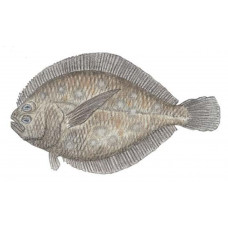Latin name
Citharichthys xanthostigma
Other names
Sanddab, soft flounder, Catalina sanddab; Spanish: lenguado alón.
Identification
The body is oblong and compressed. The head is deep, the eyes are large and located on the left side, and the mouth is large. The coloration is uniformly dark with rusty-orange or white speckles, and the pectoral fin on the eye side is black. The blind side is white. This species can be distinguished from the Pacific by the length of the pectoral fin on the eye side, which is always shorter than the head in the Pacific sanddab and longer than the head in the longfin. Sanddabs are always left-eyed, and can be distinguished from all other left-eyed flounders by the presence of a lateral line that is almost straight along its entire length.
Distribution
Occurs in the eastern Pacific Ocean from Costa Rica to Monterey, California, including the Gulf of California. North of Santa Barbara, they are rare.
Habitat
These fish usually live on sandy or muddy bottoms from 8 to 660 feet deep.
Size
These fish are usually up to 10 inches long, but also reach lengths of 153⁄4 inches.
Life history and Behavior
Females are larger than males and usually become sexually mature at age 3 and are about 71⁄2 inches long. They produce many eggs, and each fish spawns more than once per season. Spawning peaks between July and September.
Food and feeding habits
The diet is broad and includes small fish, squid, octopus, shrimp, crabs, and worms.
Reproduction
No information
| Classification | |
| Phylum | Chordata |
| Class | Actinopterygii |
| Squad | Pleuronectiformes |
| Family | Paralichthyidae |
| Genus | Citharichthys |
| Species | C. xanthostigma |
| Features | |
| Conservation status | Least Concern |
| Habitat | Pelagic |
| Life span, years | No information |
| Maximum body weight, kg | No information |
| Maximum length, cm | 25 |
| Sailing speed, m/s | No information |
| Threat to people | Edible |
| Way of eating | Predator |

